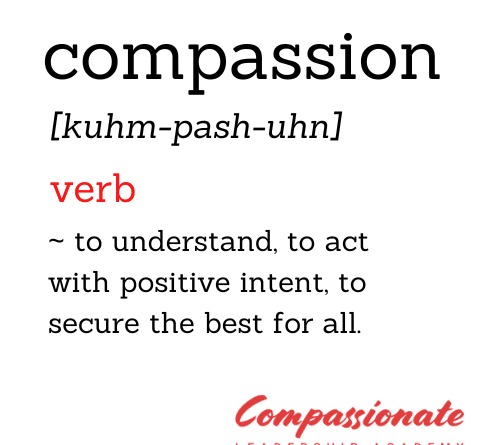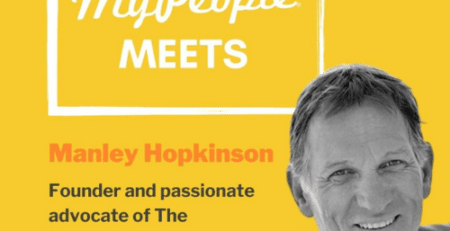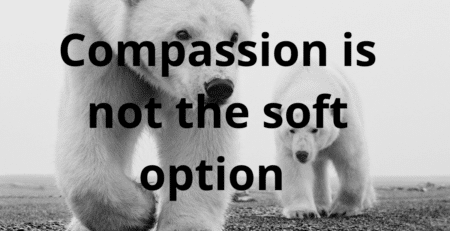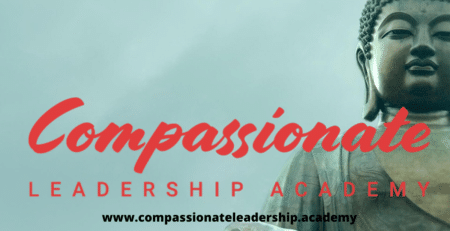
- Associations
- Compassionate Leadership

Compassion is a verb

So much has been written about the meaning of the word Compassion that seems to contradict and confuse, or, even worse, put people off practicing it. It gets confused with empathy. Becomes a synonym with mindfulness. Some inextricably link it to trauma and distress. Apparently, like Bambi on ice, compassion demands us to be vulnerable. Others even suggest that compassion is to do with shame.
Checking the dictionaries seems to bring some sort of coherence around sympathy with the Oxford saying it is “the feeling or emotion, when a person is moved by the suffering or distress of another, and by the desire to relieve it; …”. The Cambridge “a strong feeling of sympathy and sadness for other people’s suffering or bad luck and a desire to help”
All are consistent on one thing; they say compassion is a noun; I disagree.
From these descriptions I can see where the link to trauma comes from and the confusion with sympathy and empathy, and I get excited by the part that describes “desire to relieve, to alleviate and to help”, but I’m still not convinced. Dictionary definitions are fine, but what does compassion mean in practice? So let’s refer to a higher source, indeed, a person who I believe is the highest earthly source and is known, globally, to be the embodiment of compassion and the genesis of wisdom on compassion, His Holiness the Dalai Lama.
I would argue that if anyone knows what compassion is all about, then the Dalai Lama is your man. He lives, breathes, talks, teaches and practices compassion. It is deep within his DNA and at the centre of all his thoughts and actions. He has written much on the topic, but two of his quotes stand out for me;
“If empathy is to understand another, then compassion is to work with that knowledge with positive intent”. “Compassion is love”
Love. How often do we relate love to work? Not very often I’d say. But what the Dalai Lama means by love is the positive intent of your actions based on the needs of the other. It’s knowing the other and then putting them first you would do anything for someone you love and they for you too.
But if this talk of love is all too much for you then let’s focus on the first quote which we can paraphrase to “understanding with positive action”. Brilliant. Powerful. Energising. Change making and totally positive.
This is the point I want to make. You can be compassionate without trauma. You can be compassionate without vulnerability. Compassion is not sympathy, it’s not feeling sorry for someone, and it’s not all mindfulness, though that does help. Compassion is in the every day in every act. It is in helping others, helping someone across the road, picking up someone else’s litter.
Compassion is in extending your peripheral vision to “see” the needs of others and then to act with positive intent – from the heart. Compassion is to be kind, but it is also to be firm. Compassion is not soft; to always do the right thing by another will sometimes lead to tough conversations and tough decisions. Compassion is in confronting negative intent. Compassion is in not tolerating intolerance. Compassion is more than just speaking up when things are not right, it is in then acting to put them right. Compassion demands that first you strive to understand, to remove judgement and suspend your own perspective. Compassion is a verb.
Share this post
Manley Hopkinson
Leave a Reply Cancel reply
Related posts.

New Year’s Resolutions That Don’t Work
It’s easy to get swept up in the idea that come January... read more

Happy Birthday CLA
A year ago today we “soft” launched the Compassionate Leadership online Academy,... read more

MyPeople Meets – Manley Hopkinson
Read the full interview with Manley Hopkinson - Founder & passionate advocate... read more

How To Lead in Challenging Times
Thank you Matt Richardson at British Airways High Life magazine for commissioning... read more

Never Assume
“Could you shut the door please I need to start a conference... read more

Compassion is not the soft option
A polar bear can cover 50 meters in under 3 seconds It lives... read more


Psychological Safety
“There’s no team without trust,” says Paul Santagata, Head of Industry at... read more

Compassion-ism
Whilst discussing the use of my Compassionate Leadership Academy with a school... read more

Six New Year’s Resolutions For Leaders in 2021
My new year resolution to practise self-compassion is featured in Forbes magazine. ... read more

Success and Disaster in 2021
As a keynote speaker, when I share my story of skippering a... read more

Privacy Overview

How Compassion Becomes a Verb (and a Movement): The Inspiring Story of "Compassion It"
I believe that small acts of compassion by individuals can make a HUGE impact on our world. Yes, it sounds cliché and unrealistic, but I know it’s true. How can I possibly know that? Because Compassion It , the organization I’ve founded, has gone from an idea to a global social movement thanks to a handful of small acts by individuals.
Let me explain…
In the summer of 2008, I caught an episode of “Ellen” that changed my life. Ellen Degeneres interviewed an author who spoke about the power of compassion. He said it was the most important lesson to teach our children. If our future leaders would be compassionate, every social problem on the planet would be solved.
I contemplated compassion for hours that day. The word compassionate then appeared as ‘compassion it’ in my head. Compassion was now a verb! An action! That made a lot of sense to me.
But did it make sense to anyone else?
I wrote out the words ‘compassion it’ and showed it to my friends Susanne Winslow and Jill Stoddard . Because of their enthusiasm and encouragement, I decided to trademark Compassion It.
Fast-forward to the summer of 2011. I had done nothing with this simple two-word phrase, because I was busy parenting a toddler and was getting my life back on track after a failed marriage. I suddenly felt an enormous sense of urgency to do something with Compassion It . I decided to make decals and magnets, and I sat down with talented graphic designer and friend, Mary Beckert . She volunteered her time to turn my vision into something tangible.
In October of 2011, I showed a decal to my friend, Sherri Wilkins , who happens to be a marketing and advertising genius. I’ll never forget her words, “This could be huge.” WOW. Talk about fueling the fire! This propelled me to keep moving forward with my idea. Wilkins began to help me get Compassion It off the ground. In December, I caught up with my college roommate, Susan Kim . She suggested that I reach out to her friend, Tony Chen , to seek entrepreneurial advice. I called Chen, and he encouraged me to apply for a social innovation leadership academy through his current social start-up Movement121. I applied, was accepted and found myself among a group of people from around the world who all had a similar mission – to make the world a better place through social enterprise.
The academy director, Mark Chassman , created teams. Our first task as a team was to come up with a problem of the world and then create a business that would provide a solution. My team voted to use Compassion It as our business, and I was thrilled to now have a group of bright, energetic and ambitious people helping me.
Throughout all of this, I was still unsure about what Compassion It would be. Perhaps it could be the next “Life is Good,” a t-shirt company with a meaningful message. Or maybe we’ll sell bumper stickers to get this message out. I knew it would be some sort of business whose profits would go toward compassion education in schools.
I felt deep down, though, that Compassion It was a social movement. It was much more than just a t-shirt company. Compassion It was a way to live.
I expressed these thoughts with Sherri Wilkins, who said, “If you want it to be a social movement, you need to sell something less expensive than a t-shirt. You need something small…like a bracelet.” Soon thereafter, I thought of creating reversible bracelets that would inspire compassionate actions.
Heather Arnold , from my Movement121 team, came up with the brilliant idea to sell the bracelets in pairs. That way, a person’s first act of compassion is to give the other bracelet away.
That first batch of bracelets arrived on my birthday – May 10, 2012. I had 500 pairs.
My next question was, “Who is going to buy them?”
In the beginning of the summer, two of my teammates from the academy faced tragedy when their hometown of Northbrook, Ill., lost two young men to suicide and another to a car accident within three weeks. Teammate Casey Tanner called and said that her town needed Compassion It as a way to unite and grieve. She started a movement in Northbrook and used the bracelets as a fundraiser for the boys’ families. Bracelets sold out in 42 minutes. Thousands of residents of Northbrook still ‘compassion it’ daily in honor of those men.
One Northbrook resident, Marie Wojtan , sent her extra bracelet to a young woman in Great Britain by the name of Carrie Hope Fletcher . Fletcher has over 90,000 subscribers to her YouTube channel, and she posted a ‘jolly good’ bit about her Compassion It bracelet.
Thanks to Fletcher’s post (which has generated over 100,000 views), we’ve sold Compassion It bracelets to folks in England, Ireland, Switzerland, Germany, Denmark, Brazil, Australia, New Zealand and Canada. Thousands of people all over the world now ‘compassion it’ each day.
And to think…if it weren’t for Ellen, Susanne, Jill, Mary, Sherri, Susan, Tony, Mark, Heather, Casey, Marie and Carrie, Compassion It would not exist as a global social movement.
This is just the beginning of a movement that I believe can improve the social consciousness of the world and ultimately lead to peace. All it takes are small acts of compassion by each one of us.
Compassion: Its mission is to inspire daily compassionate actions. Please join me, and let’s ‘ compassion it ’!
About the Author
Sara schairer.
Sara Schairer is the founder and executive director of COMPASSION IT, a start-up nonprofit organization and global social movement whose mission is to inspire daily compassionate actions and attitudes. She created the one-of-a-kind reversible COMPASSION IT wristband prompting compassionate actions on six continents, 48 countries, and all 50 states. A Stanford-certified instructor of Compassion Cultivation Training (CCT), Sara has taught CCT at the UCSD Center for Mindfulness, Kaiser Permanente, the Naval Medical Center, and this past November she led compassion trainings in Africa sponsored by the Botswana Ministries of Health and Education. She’s also a contributing author to the book The Neuroscience of Learning and Development: Enhancing Creativity, Compassion, Critical Thinking and Peace in Higher Education.

SUBSCRIBE TO OUR NEWSLETTER

Sign Up for a Free Consultation
Scroll to Top

IMAGES
VIDEO
COMMENTS
Compassion demands that first you strive to understand, to remove judgement and suspend your own perspective. Compassion is a verb. So much has been written about the meaning of the word Compassion that seems to contradict and confuse, or, even worse, put people off practicing it.It gets confused with empathy. Becomes a synonym with mindfulness.
Compassion was now a verb! An action! That made a lot of sense to me. But did it make sense to anyone else? I wrote out the words ‘compassion it’ and showed it to my friends Susanne Winslow and Jill Stoddard. Because of their enthusiasm and encouragement, I decided to trademark Compassion It. Fast-forward to the summer of 2011.
InnerSelf Magazine has been published since 1985. As Thich Nhat Hanh, the Vietnamese Zen monk, points out, "Compassion is a verb". It is not a thought or a sentimental feeling, but is rather a movement of the heart. As classically defined in Pali, compassion is "the trembling or the quivering of the heart". But how do we get our hearts to do that?